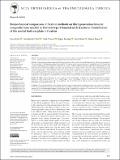Please use this identifier to cite or link to this item:
http://hdl.handle.net/11547/11767| Title: | Biomechanical comparison of fixation methods on third-generation femoral composite bone models in Pauwels type 3 femoral neck fractures: Contribution of the medial buttress plate to fixation |
| Authors: | Kılıç, Feyzi |
| Issue Date: | 2023 |
| Abstract: | Objective: To compare the use of cannulated screws in an inverted triangular configuration, medial buttress plates, and the combination of these 2 fixation methods in the treatment of Pauwels type 3 femoral neck fractures.Methods: Twenty-eight anatomical composite third-generation femoral bone models were divided into 4 groups. The control group (group 1) was formed with 7 third-generation intact bone models. The fracture model was created with a 70 degrees cutting block to fit 21 Pauwels type 3 fracture configurations. Seven models were fixed with an isolated 3.5 mm one-third semi-tubular medial buttress plate (group 2), 7 were fixed in an inverted triangular configuration with 6.5 mm cannulated screws (group 3), and 7 were fixed using a combination of 6.5 mm cannulated screws and a medial buttress plate (group 4). Cyclic loading was applied using axial forces ranging from 60 N to 600 N and moments ranging from 0.7 Nm to 7.0 Nm for 500 cycles. Once the cyclic loading stage was completed, the loads were removed from the system, and the quasistatic loading stage was employed to determine the stiffness and failure forces of the system under both axial and torsional forces. Quasistatic tests were performed with an axial speed of 1.8 mm/min and a torsional speed of 4.5 degrees/min. The biomechanical properties of all groups were examined in terms of axial stiffness, torsional stiffness, and maximum axial force parameters.Results: The stiffness values of groups 1, 2, 3, and 4 were 303 +/- 35.8 N/mm, 159.6 +/- 25 N/mm, 232 +/- 35.9 N/mm, and 366.9 +/- 58 N/mm, respectively, under axial forces (P < .01); 2172.7 +/- 252.1 Nmm/degrees degrees , 1225.3 +/- 238.6 Nmm/degrees, 2123 +/- 359.4 Nmm/degrees, and 2721.85 +/- 304 Nmm/degrees, respectively, under torsional moments (P < .01); and 2072.1 +/- 256.1 N, 1379.9 +/- 290.6 N, 2099.1 +/- 454.2 N, and 2648.4 +/- 364.6 N, respectively, under the maximum force (P < .01).Conclusion: This study showed that in the fixation of Pauwels type 3 fractures formed on third-generation bone models, the utilization of half-thread cannulated screws in an inverted triangle configuration, along with a medial buttress plate, provided stronger fixation compared to the remaining implant groups and the control group. According to the evaluation of the parameters, the isolated application of a medial buttress plate had poorer biomechanical properties than other fixation methods. |
| URI: | http://hdl.handle.net/11547/11767 |
| ISSN: | 1017-995X |
| Appears in Collections: | Web Of Science |
Files in This Item:
| File | Description | Size | Format | |
|---|---|---|---|---|
| 243-249.pdf | 2.42 MB | Adobe PDF |  View/Open |
Items in DSpace are protected by copyright, with all rights reserved, unless otherwise indicated.
